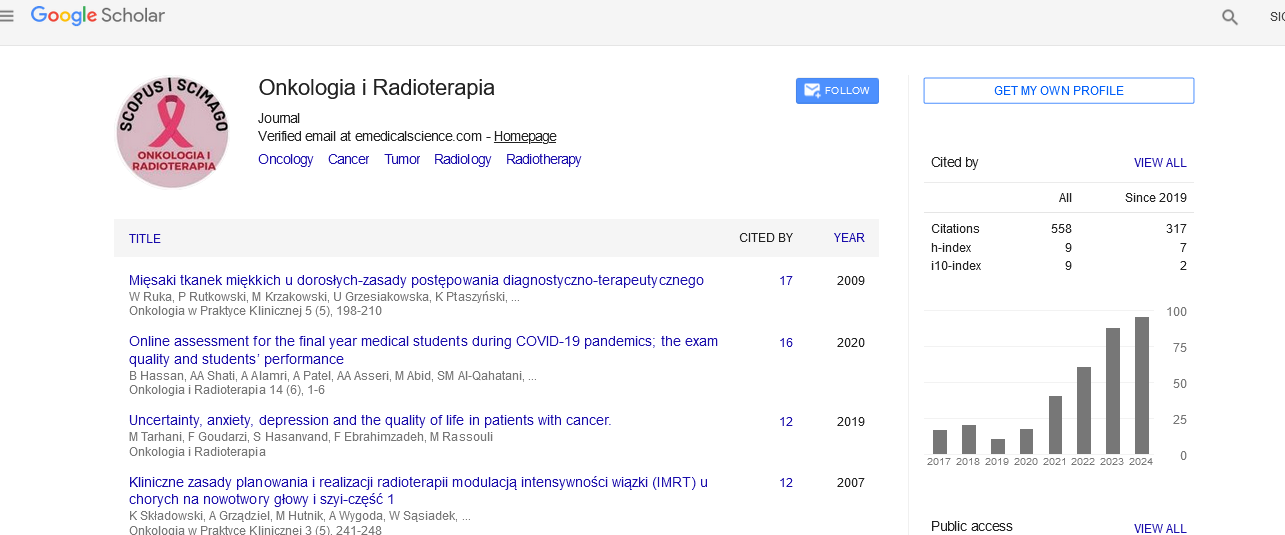Perspective - Onkologia i Radioterapia ( 2024) Volume 18, Issue 11
Biopsies in oncology: Advancing diagnosis, treatment, and progress against cancer
Richard Hughes*Richard Hughes, Department of Epidemiology, Boston University School of Public Health, Boston, Massachusetts, USA, Email: rhughes@leeds.ac.uk
Received: 30-Oct-2023, Manuscript No. OAR-24-118751; , Pre QC No. OAR-24-118751 (PQ); Editor assigned: 01-Nov-2023, Pre QC No. OAR-24-118751 (PQ); Reviewed: 15-Nov-2023, QC No. OAR-24-118751; Revised: 21-Nov-2024, Manuscript No. OAR-24-118751 (R); Published: 29-Nov-2024
Introduction
In the quest to unravel the mysteries of cancer and provide patients with precise diagnoses and treatment plans, the humble yet transformative biopsy takes center stage. As a diagnostic procedure, biopsies play an indispensable role in the early detection, characterization, and treatment of cancer. In this commentary article, we delve into the world of biopsies, shedding light on their remarkable contributions, advancements, and enduring impact on the battle against cancer.
Description
The essence of a biopsy
At its core, a biopsy is a medical procedure that involves the removal and examination of a small sample of tissue, cells, or fluid from a suspicious lesion, organ, or part of the body. The primary objective of a biopsy is to determine whether the tissue is cancerous, benign, or potentially precancerous. This procedure provides critical information for a definitive cancer diagnosis and guides the choice of treatment.
Types of biopsies
Biopsies come in various forms, each tailored to the location and nature of the suspected cancer:
Needle biopsy: Needle biopsies involve the use of a fine needle to extract a small sample of tissue or fluid. There are different subtypes of needle biopsies, including Fine-Needle Aspiration (FNA), core needle biopsy, and vacuum-assisted biopsy.
Endoscopic biopsy: In cases where the suspected cancer is located inside body cavities or organs, endoscopic biopsies use a thin, flexible tube with a camera and tools to collect samples.
Surgical biopsy: Surgical biopsies entail the removal of a larger section of tissue through surgery. This approach is often employed when a larger sample is needed for a conclusive diagnosis.
Liquid biopsy: Liquid biopsies are a relatively new development that involves the analysis of blood or other bodily fluids for cancerrelated genetic mutations, proteins, or fragments of cancer cells. They offer a non-invasive and less painful alternative to traditional biopsies.
Applications and transformative impact
The applications of biopsies in the field of oncology are vast, and their impact on cancer diagnosis and treatment is profound:
Early detection: Biopsies are crucial for the early detection of cancer. By identifying cancer at its earliest stages, patients have a higher chance of successful treatment and improved outcomes.
Characterization: Biopsies help healthcare providers understand the type of cancer and its specific characteristics, such as grade, stage, and genetic mutations. This information guides the choice of treatment and prognosis.
Treatment planning: The results of a biopsy are instrumental in developing personalized treatment plans. They help determine whether surgery, chemotherapy, radiation therapy, immunotherapy, or targeted therapy is most appropriate.
Monitoring response to treatment: Biopsies can also be used to assess how well a patient is responding to cancer treatment. Changes in the tumor following therapy can help refine the treatment plan.
Research and clinical trials: Biopsies contribute to cancer research and the development of new treatments. They provide essential data for clinical trials testing innovative therapies.
Challenges and hurdles
While biopsies are invaluable, they come with challenges and limitations:
Invasive nature: Traditional biopsies are invasive procedures that can be uncomfortable and carry some risks, such as infection or bleeding.
Sampling error: Biopsies are subject to sampling errors. A biopsy may miss cancerous cells, leading to a false negative result, or provide inconclusive findings.
Complications: In some cases, especially with surgical biopsies, complications may arise. Careful post-biopsy monitoring is essential.
Patient anxiety: The process of waiting for biopsy results can be stressful for patients, leading to anxiety and uncertainty.
The future of biopsies
The future of biopsies is marked by innovation and advancement:
Non-invasive diagnostics: Liquid biopsies, which offer a noninvasive method to detect cancer-related biomarkers in blood or other bodily fluids, are gaining prominence. They have the potential to revolutionize early cancer detection.
Precision medicine: Biopsies will continue to play a central role in the era of precision medicine. Tissue and genetic profiling will guide the development of tailored treatment plans for individual patients.
Minimally invasive techniques: Advances in biopsy techniques are making procedures less invasive, more accurate, and less painful for patients.
Artificial intelligence: The integration of artificial intelligence and machine learning in the analysis of biopsy samples is expected to improve the speed and accuracy of diagnosis.
Conclusion
Biopsies stand as a cornerstone in the journey to defeat cancer. Their role in early detection, characterization, treatment planning, and research is unparalleled. The impact of a biopsy extends beyond diagnosis; it is a vital tool that brings hope and guidance to patients and their healthcare providers.
As we look ahead to the future of biopsies, we anticipate noninvasive diagnostics, precision medicine, and minimally invasive techniques that will further enhance the accuracy and comfort of these procedures.



